Human Resource Management Report: Unit 3 HRM Practices and Legislation
VerifiedAdded on 2023/01/03
|15
|3942
|459
Report
AI Summary
This report provides a comprehensive overview of Human Resource Management (HRM) practices, focusing on workforce planning, recruitment and selection, employee relations, and employment legislation. The report begins by explaining the purpose and functions of HRM within an organization, using Sainsbury as a case study. It then explores different approaches to recruitment and selection, analyzing their strengths and weaknesses. The report further examines the benefits of various HRM practices, such as training and development, performance management, and rewards management, for both employers and employees. The effectiveness of these practices in terms of raising organizational profit and productivity is also evaluated. Additionally, the report analyzes the importance of employee relations and the impact of employment legislation on HRM decision-making. The application of HRM practices is illustrated through specific examples, providing a practical understanding of the concepts discussed.
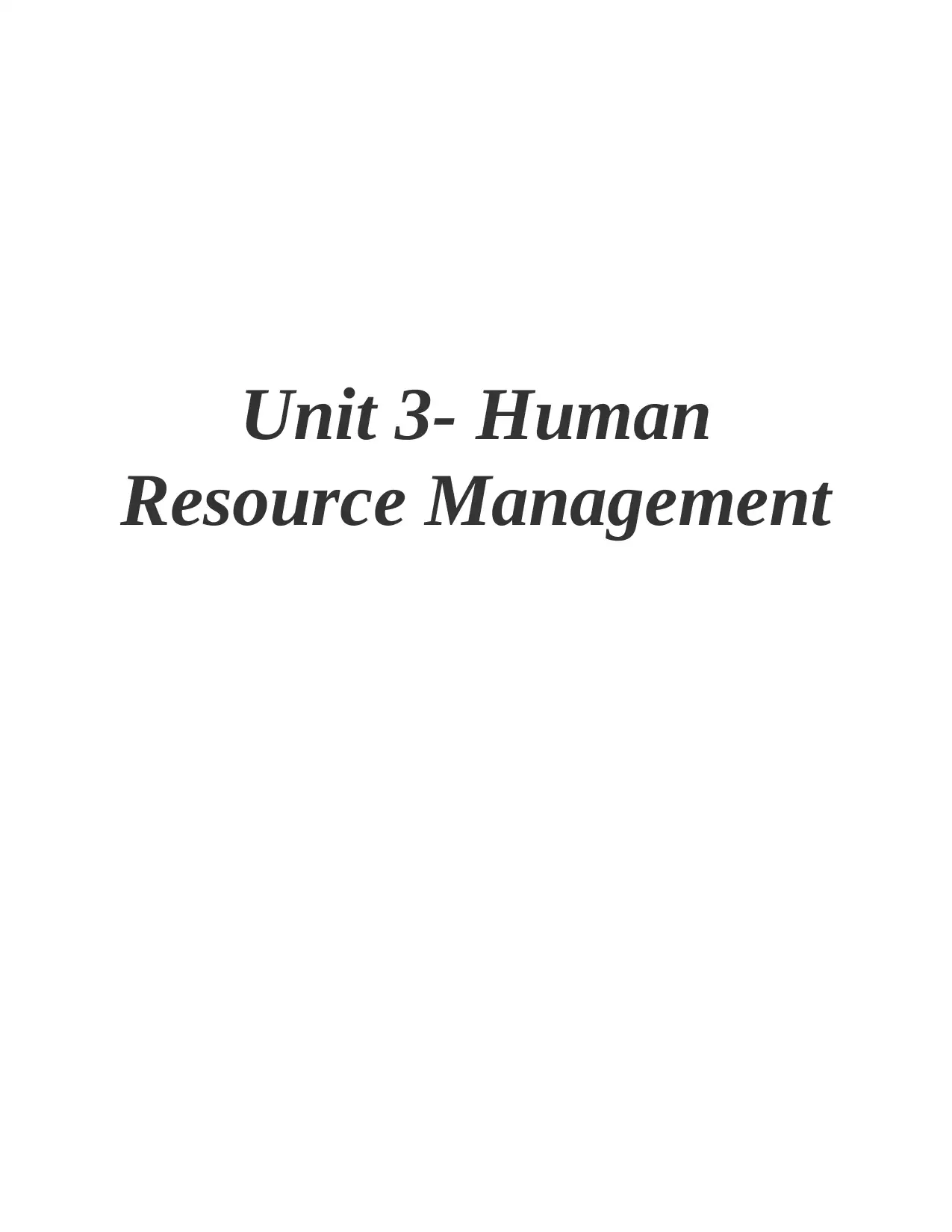
Unit 3- Human
Resource Management
Resource Management
Paraphrase This Document
Need a fresh take? Get an instant paraphrase of this document with our AI Paraphraser
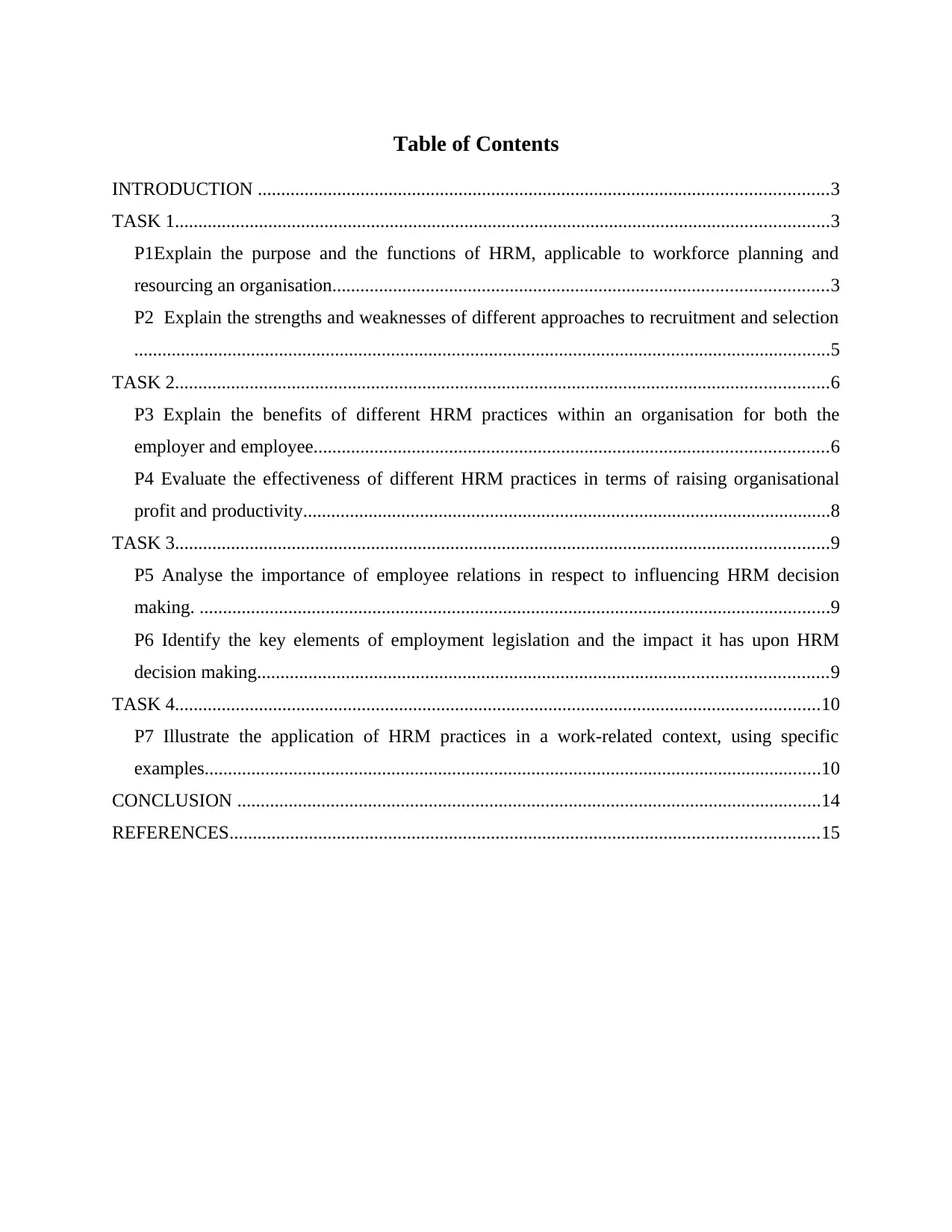
Table of Contents
INTRODUCTION ..........................................................................................................................3
TASK 1............................................................................................................................................3
P1Explain the purpose and the functions of HRM, applicable to workforce planning and
resourcing an organisation..........................................................................................................3
P2 Explain the strengths and weaknesses of different approaches to recruitment and selection
.....................................................................................................................................................5
TASK 2............................................................................................................................................6
P3 Explain the benefits of different HRM practices within an organisation for both the
employer and employee..............................................................................................................6
P4 Evaluate the effectiveness of different HRM practices in terms of raising organisational
profit and productivity.................................................................................................................8
TASK 3............................................................................................................................................9
P5 Analyse the importance of employee relations in respect to influencing HRM decision
making. .......................................................................................................................................9
P6 Identify the key elements of employment legislation and the impact it has upon HRM
decision making..........................................................................................................................9
TASK 4..........................................................................................................................................10
P7 Illustrate the application of HRM practices in a work-related context, using specific
examples....................................................................................................................................10
CONCLUSION .............................................................................................................................14
REFERENCES..............................................................................................................................15
INTRODUCTION ..........................................................................................................................3
TASK 1............................................................................................................................................3
P1Explain the purpose and the functions of HRM, applicable to workforce planning and
resourcing an organisation..........................................................................................................3
P2 Explain the strengths and weaknesses of different approaches to recruitment and selection
.....................................................................................................................................................5
TASK 2............................................................................................................................................6
P3 Explain the benefits of different HRM practices within an organisation for both the
employer and employee..............................................................................................................6
P4 Evaluate the effectiveness of different HRM practices in terms of raising organisational
profit and productivity.................................................................................................................8
TASK 3............................................................................................................................................9
P5 Analyse the importance of employee relations in respect to influencing HRM decision
making. .......................................................................................................................................9
P6 Identify the key elements of employment legislation and the impact it has upon HRM
decision making..........................................................................................................................9
TASK 4..........................................................................................................................................10
P7 Illustrate the application of HRM practices in a work-related context, using specific
examples....................................................................................................................................10
CONCLUSION .............................................................................................................................14
REFERENCES..............................................................................................................................15
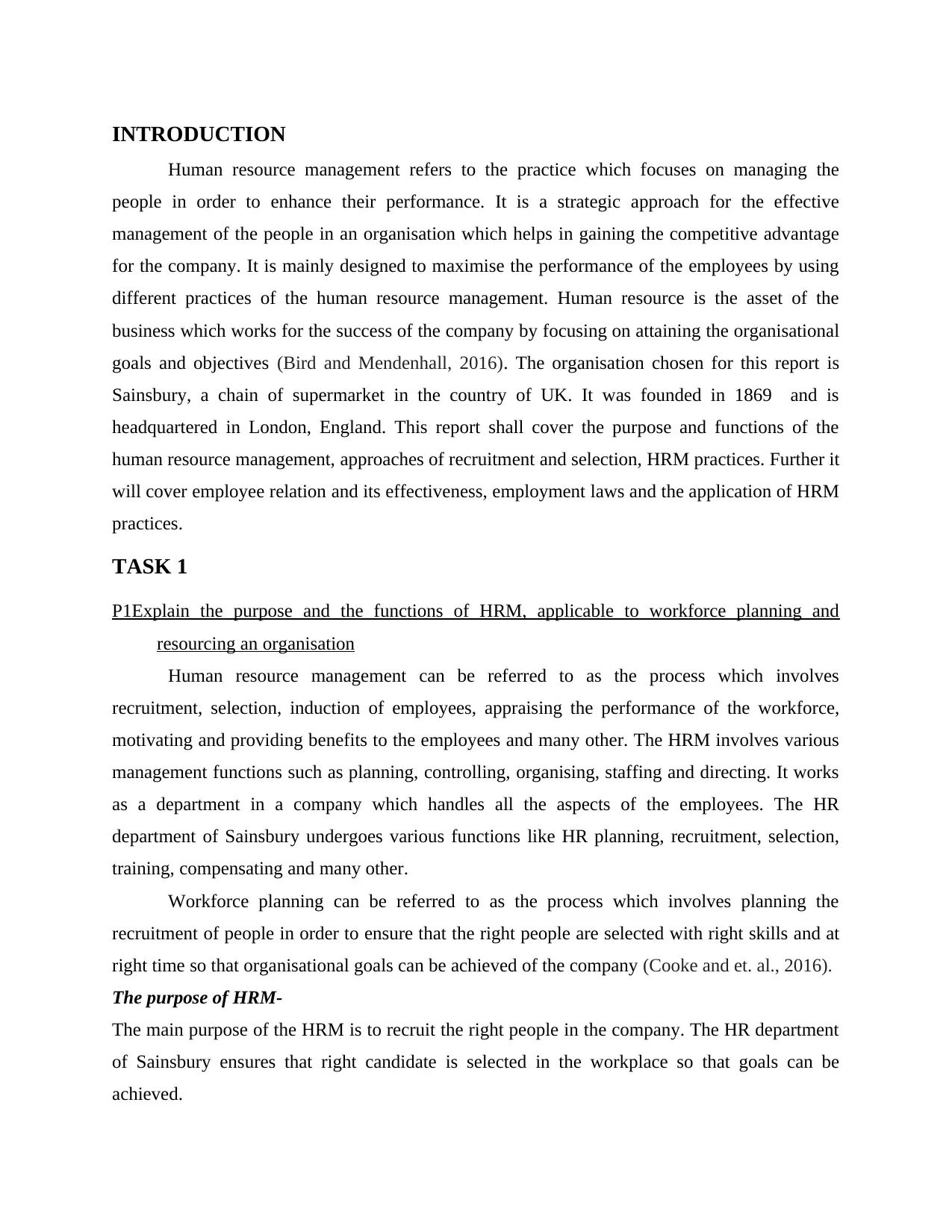
INTRODUCTION
Human resource management refers to the practice which focuses on managing the
people in order to enhance their performance. It is a strategic approach for the effective
management of the people in an organisation which helps in gaining the competitive advantage
for the company. It is mainly designed to maximise the performance of the employees by using
different practices of the human resource management. Human resource is the asset of the
business which works for the success of the company by focusing on attaining the organisational
goals and objectives (Bird and Mendenhall, 2016). The organisation chosen for this report is
Sainsbury, a chain of supermarket in the country of UK. It was founded in 1869 and is
headquartered in London, England. This report shall cover the purpose and functions of the
human resource management, approaches of recruitment and selection, HRM practices. Further it
will cover employee relation and its effectiveness, employment laws and the application of HRM
practices.
TASK 1
P1Explain the purpose and the functions of HRM, applicable to workforce planning and
resourcing an organisation
Human resource management can be referred to as the process which involves
recruitment, selection, induction of employees, appraising the performance of the workforce,
motivating and providing benefits to the employees and many other. The HRM involves various
management functions such as planning, controlling, organising, staffing and directing. It works
as a department in a company which handles all the aspects of the employees. The HR
department of Sainsbury undergoes various functions like HR planning, recruitment, selection,
training, compensating and many other.
Workforce planning can be referred to as the process which involves planning the
recruitment of people in order to ensure that the right people are selected with right skills and at
right time so that organisational goals can be achieved of the company (Cooke and et. al., 2016).
The purpose of HRM-
The main purpose of the HRM is to recruit the right people in the company. The HR department
of Sainsbury ensures that right candidate is selected in the workplace so that goals can be
achieved.
Human resource management refers to the practice which focuses on managing the
people in order to enhance their performance. It is a strategic approach for the effective
management of the people in an organisation which helps in gaining the competitive advantage
for the company. It is mainly designed to maximise the performance of the employees by using
different practices of the human resource management. Human resource is the asset of the
business which works for the success of the company by focusing on attaining the organisational
goals and objectives (Bird and Mendenhall, 2016). The organisation chosen for this report is
Sainsbury, a chain of supermarket in the country of UK. It was founded in 1869 and is
headquartered in London, England. This report shall cover the purpose and functions of the
human resource management, approaches of recruitment and selection, HRM practices. Further it
will cover employee relation and its effectiveness, employment laws and the application of HRM
practices.
TASK 1
P1Explain the purpose and the functions of HRM, applicable to workforce planning and
resourcing an organisation
Human resource management can be referred to as the process which involves
recruitment, selection, induction of employees, appraising the performance of the workforce,
motivating and providing benefits to the employees and many other. The HRM involves various
management functions such as planning, controlling, organising, staffing and directing. It works
as a department in a company which handles all the aspects of the employees. The HR
department of Sainsbury undergoes various functions like HR planning, recruitment, selection,
training, compensating and many other.
Workforce planning can be referred to as the process which involves planning the
recruitment of people in order to ensure that the right people are selected with right skills and at
right time so that organisational goals can be achieved of the company (Cooke and et. al., 2016).
The purpose of HRM-
The main purpose of the HRM is to recruit the right people in the company. The HR department
of Sainsbury ensures that right candidate is selected in the workplace so that goals can be
achieved.
⊘ This is a preview!⊘
Do you want full access?
Subscribe today to unlock all pages.

Trusted by 1+ million students worldwide
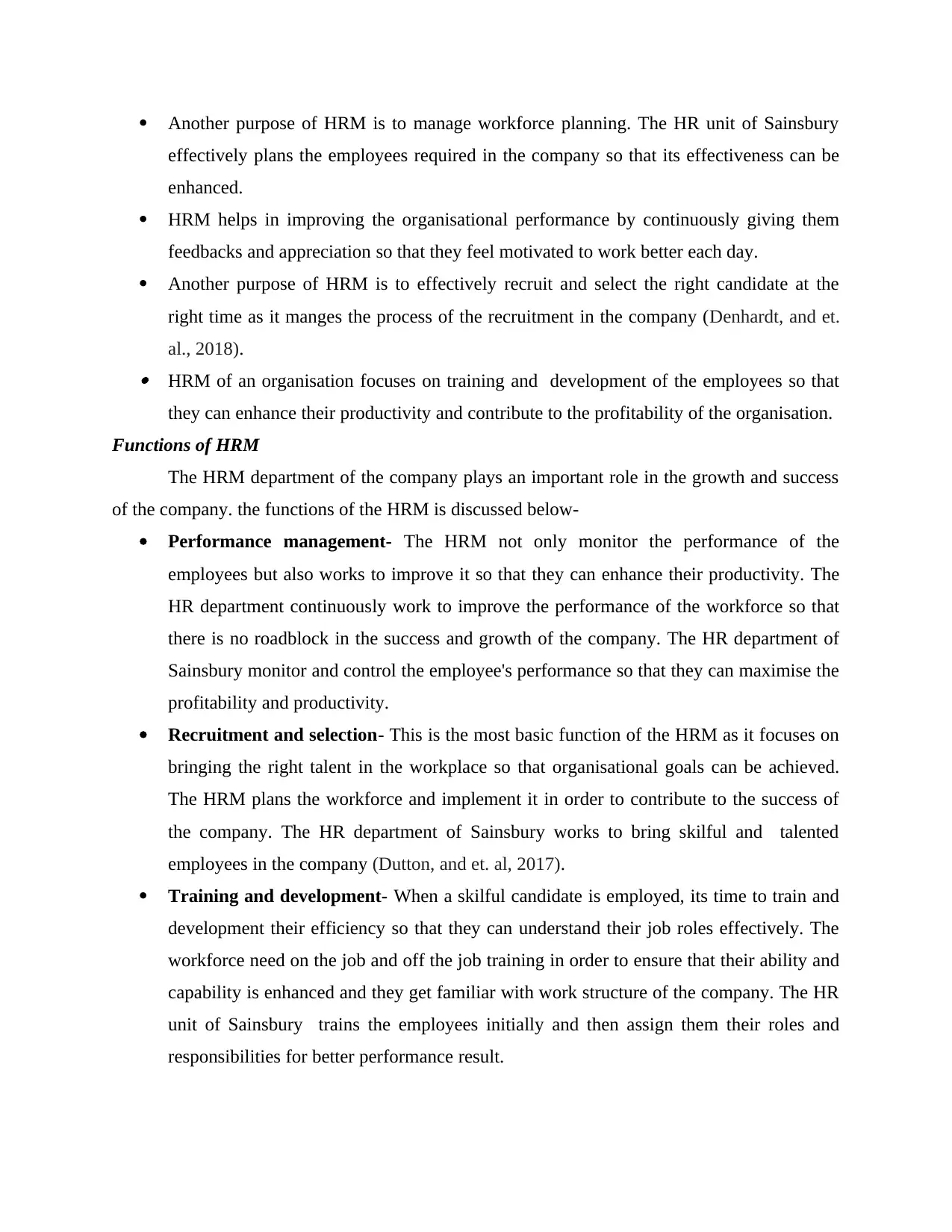
Another purpose of HRM is to manage workforce planning. The HR unit of Sainsbury
effectively plans the employees required in the company so that its effectiveness can be
enhanced.
HRM helps in improving the organisational performance by continuously giving them
feedbacks and appreciation so that they feel motivated to work better each day.
Another purpose of HRM is to effectively recruit and select the right candidate at the
right time as it manges the process of the recruitment in the company (Denhardt, and et.
al., 2018). HRM of an organisation focuses on training and development of the employees so that
they can enhance their productivity and contribute to the profitability of the organisation.
Functions of HRM
The HRM department of the company plays an important role in the growth and success
of the company. the functions of the HRM is discussed below-
Performance management- The HRM not only monitor the performance of the
employees but also works to improve it so that they can enhance their productivity. The
HR department continuously work to improve the performance of the workforce so that
there is no roadblock in the success and growth of the company. The HR department of
Sainsbury monitor and control the employee's performance so that they can maximise the
profitability and productivity.
Recruitment and selection- This is the most basic function of the HRM as it focuses on
bringing the right talent in the workplace so that organisational goals can be achieved.
The HRM plans the workforce and implement it in order to contribute to the success of
the company. The HR department of Sainsbury works to bring skilful and talented
employees in the company (Dutton, and et. al, 2017).
Training and development- When a skilful candidate is employed, its time to train and
development their efficiency so that they can understand their job roles effectively. The
workforce need on the job and off the job training in order to ensure that their ability and
capability is enhanced and they get familiar with work structure of the company. The HR
unit of Sainsbury trains the employees initially and then assign them their roles and
responsibilities for better performance result.
effectively plans the employees required in the company so that its effectiveness can be
enhanced.
HRM helps in improving the organisational performance by continuously giving them
feedbacks and appreciation so that they feel motivated to work better each day.
Another purpose of HRM is to effectively recruit and select the right candidate at the
right time as it manges the process of the recruitment in the company (Denhardt, and et.
al., 2018). HRM of an organisation focuses on training and development of the employees so that
they can enhance their productivity and contribute to the profitability of the organisation.
Functions of HRM
The HRM department of the company plays an important role in the growth and success
of the company. the functions of the HRM is discussed below-
Performance management- The HRM not only monitor the performance of the
employees but also works to improve it so that they can enhance their productivity. The
HR department continuously work to improve the performance of the workforce so that
there is no roadblock in the success and growth of the company. The HR department of
Sainsbury monitor and control the employee's performance so that they can maximise the
profitability and productivity.
Recruitment and selection- This is the most basic function of the HRM as it focuses on
bringing the right talent in the workplace so that organisational goals can be achieved.
The HRM plans the workforce and implement it in order to contribute to the success of
the company. The HR department of Sainsbury works to bring skilful and talented
employees in the company (Dutton, and et. al, 2017).
Training and development- When a skilful candidate is employed, its time to train and
development their efficiency so that they can understand their job roles effectively. The
workforce need on the job and off the job training in order to ensure that their ability and
capability is enhanced and they get familiar with work structure of the company. The HR
unit of Sainsbury trains the employees initially and then assign them their roles and
responsibilities for better performance result.
Paraphrase This Document
Need a fresh take? Get an instant paraphrase of this document with our AI Paraphraser

P2 Explain the strengths and weaknesses of different approaches to recruitment and selection
Recruitment
It refers to the process which involves searching for the perspective employees and then
stimulating them so that they apply for the jobs in an organisation. It is the first stage in the
process which is continued by selection and ends with the placement.
The recruitment process is the searching of the right candidate and then informing them
about the opening in the company. The approaches of recruitment in context to Sainsbury is
discussed below-
Internal approaches
Under this, applicant is seek for the position within the organisation who are currently
employed in the company. It includes- Transfer- It mainly refers to changing the responsibilities of the job and the profile. It is
a horizontal shift of the workforce fro, same status of the job with similar package
(Mijumbi, and et. al., 2016).
Strength- This approach helps the employee to gain experience from different field which will
help in development of the new skills and knowledge.
Weakness- Sometimes, this approach may be not be suitable for the employee and become
burden to perform the job role effectively. Promotion- In this, the workforce is promoted to higher job profile from its current
profile which results in more responsibilities and progress with the high authority.
Strength- It is highly effective as employee is already familiar with the environment of the
workplace.
Weakness- This approach may become a hurdle in recruiting the fresh and new talent into the
organisation.
External approaches
Under this approach, the fresh talent is searched outside the workplace (Naser, and et. al.,
2016). It includes- Advertisement- In this, the organisation publishes an advertisement in the newspaper or
the magazine and invites the people to apply for the job.
Strength- This source helps in screening the applicants from wide range of population which
helps in recruiting the right person.
Recruitment
It refers to the process which involves searching for the perspective employees and then
stimulating them so that they apply for the jobs in an organisation. It is the first stage in the
process which is continued by selection and ends with the placement.
The recruitment process is the searching of the right candidate and then informing them
about the opening in the company. The approaches of recruitment in context to Sainsbury is
discussed below-
Internal approaches
Under this, applicant is seek for the position within the organisation who are currently
employed in the company. It includes- Transfer- It mainly refers to changing the responsibilities of the job and the profile. It is
a horizontal shift of the workforce fro, same status of the job with similar package
(Mijumbi, and et. al., 2016).
Strength- This approach helps the employee to gain experience from different field which will
help in development of the new skills and knowledge.
Weakness- Sometimes, this approach may be not be suitable for the employee and become
burden to perform the job role effectively. Promotion- In this, the workforce is promoted to higher job profile from its current
profile which results in more responsibilities and progress with the high authority.
Strength- It is highly effective as employee is already familiar with the environment of the
workplace.
Weakness- This approach may become a hurdle in recruiting the fresh and new talent into the
organisation.
External approaches
Under this approach, the fresh talent is searched outside the workplace (Naser, and et. al.,
2016). It includes- Advertisement- In this, the organisation publishes an advertisement in the newspaper or
the magazine and invites the people to apply for the job.
Strength- This source helps in screening the applicants from wide range of population which
helps in recruiting the right person.
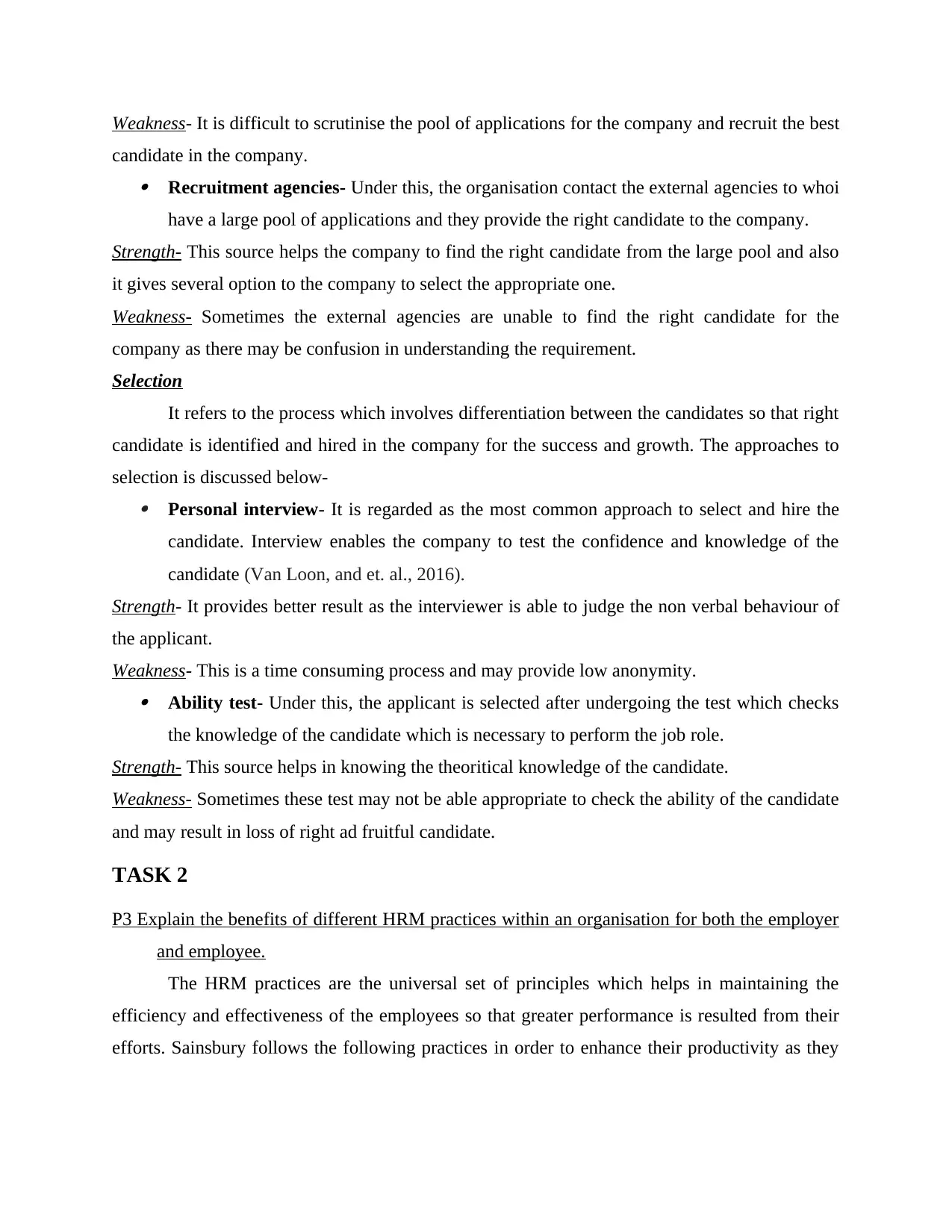
Weakness- It is difficult to scrutinise the pool of applications for the company and recruit the best
candidate in the company. Recruitment agencies- Under this, the organisation contact the external agencies to whoi
have a large pool of applications and they provide the right candidate to the company.
Strength- This source helps the company to find the right candidate from the large pool and also
it gives several option to the company to select the appropriate one.
Weakness- Sometimes the external agencies are unable to find the right candidate for the
company as there may be confusion in understanding the requirement.
Selection
It refers to the process which involves differentiation between the candidates so that right
candidate is identified and hired in the company for the success and growth. The approaches to
selection is discussed below- Personal interview- It is regarded as the most common approach to select and hire the
candidate. Interview enables the company to test the confidence and knowledge of the
candidate (Van Loon, and et. al., 2016).
Strength- It provides better result as the interviewer is able to judge the non verbal behaviour of
the applicant.
Weakness- This is a time consuming process and may provide low anonymity. Ability test- Under this, the applicant is selected after undergoing the test which checks
the knowledge of the candidate which is necessary to perform the job role.
Strength- This source helps in knowing the theoritical knowledge of the candidate.
Weakness- Sometimes these test may not be able appropriate to check the ability of the candidate
and may result in loss of right ad fruitful candidate.
TASK 2
P3 Explain the benefits of different HRM practices within an organisation for both the employer
and employee.
The HRM practices are the universal set of principles which helps in maintaining the
efficiency and effectiveness of the employees so that greater performance is resulted from their
efforts. Sainsbury follows the following practices in order to enhance their productivity as they
candidate in the company. Recruitment agencies- Under this, the organisation contact the external agencies to whoi
have a large pool of applications and they provide the right candidate to the company.
Strength- This source helps the company to find the right candidate from the large pool and also
it gives several option to the company to select the appropriate one.
Weakness- Sometimes the external agencies are unable to find the right candidate for the
company as there may be confusion in understanding the requirement.
Selection
It refers to the process which involves differentiation between the candidates so that right
candidate is identified and hired in the company for the success and growth. The approaches to
selection is discussed below- Personal interview- It is regarded as the most common approach to select and hire the
candidate. Interview enables the company to test the confidence and knowledge of the
candidate (Van Loon, and et. al., 2016).
Strength- It provides better result as the interviewer is able to judge the non verbal behaviour of
the applicant.
Weakness- This is a time consuming process and may provide low anonymity. Ability test- Under this, the applicant is selected after undergoing the test which checks
the knowledge of the candidate which is necessary to perform the job role.
Strength- This source helps in knowing the theoritical knowledge of the candidate.
Weakness- Sometimes these test may not be able appropriate to check the ability of the candidate
and may result in loss of right ad fruitful candidate.
TASK 2
P3 Explain the benefits of different HRM practices within an organisation for both the employer
and employee.
The HRM practices are the universal set of principles which helps in maintaining the
efficiency and effectiveness of the employees so that greater performance is resulted from their
efforts. Sainsbury follows the following practices in order to enhance their productivity as they
⊘ This is a preview!⊘
Do you want full access?
Subscribe today to unlock all pages.

Trusted by 1+ million students worldwide
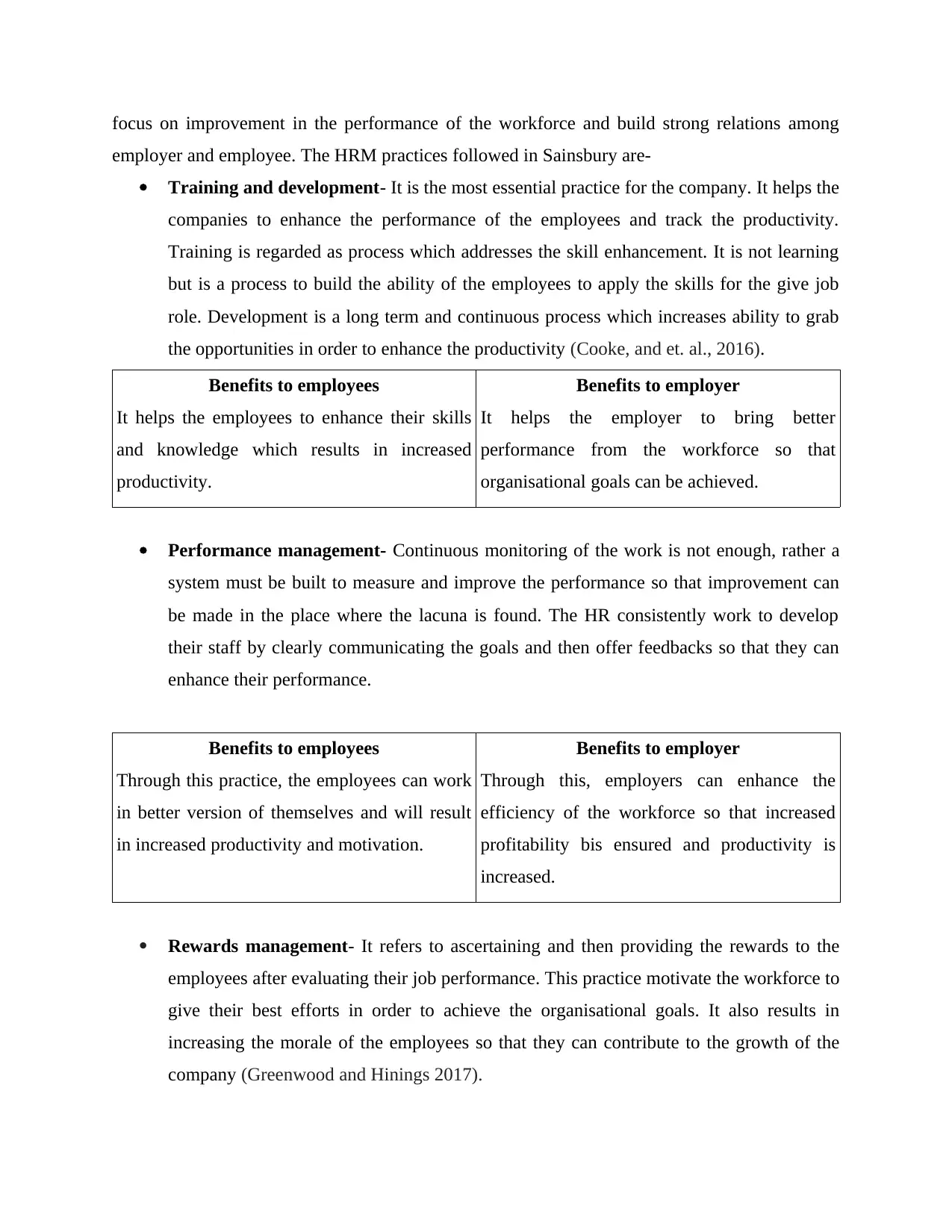
focus on improvement in the performance of the workforce and build strong relations among
employer and employee. The HRM practices followed in Sainsbury are-
Training and development- It is the most essential practice for the company. It helps the
companies to enhance the performance of the employees and track the productivity.
Training is regarded as process which addresses the skill enhancement. It is not learning
but is a process to build the ability of the employees to apply the skills for the give job
role. Development is a long term and continuous process which increases ability to grab
the opportunities in order to enhance the productivity (Cooke, and et. al., 2016).
Benefits to employees
It helps the employees to enhance their skills
and knowledge which results in increased
productivity.
Benefits to employer
It helps the employer to bring better
performance from the workforce so that
organisational goals can be achieved.
Performance management- Continuous monitoring of the work is not enough, rather a
system must be built to measure and improve the performance so that improvement can
be made in the place where the lacuna is found. The HR consistently work to develop
their staff by clearly communicating the goals and then offer feedbacks so that they can
enhance their performance.
Benefits to employees
Through this practice, the employees can work
in better version of themselves and will result
in increased productivity and motivation.
Benefits to employer
Through this, employers can enhance the
efficiency of the workforce so that increased
profitability bis ensured and productivity is
increased.
Rewards management- It refers to ascertaining and then providing the rewards to the
employees after evaluating their job performance. This practice motivate the workforce to
give their best efforts in order to achieve the organisational goals. It also results in
increasing the morale of the employees so that they can contribute to the growth of the
company (Greenwood and Hinings 2017).
employer and employee. The HRM practices followed in Sainsbury are-
Training and development- It is the most essential practice for the company. It helps the
companies to enhance the performance of the employees and track the productivity.
Training is regarded as process which addresses the skill enhancement. It is not learning
but is a process to build the ability of the employees to apply the skills for the give job
role. Development is a long term and continuous process which increases ability to grab
the opportunities in order to enhance the productivity (Cooke, and et. al., 2016).
Benefits to employees
It helps the employees to enhance their skills
and knowledge which results in increased
productivity.
Benefits to employer
It helps the employer to bring better
performance from the workforce so that
organisational goals can be achieved.
Performance management- Continuous monitoring of the work is not enough, rather a
system must be built to measure and improve the performance so that improvement can
be made in the place where the lacuna is found. The HR consistently work to develop
their staff by clearly communicating the goals and then offer feedbacks so that they can
enhance their performance.
Benefits to employees
Through this practice, the employees can work
in better version of themselves and will result
in increased productivity and motivation.
Benefits to employer
Through this, employers can enhance the
efficiency of the workforce so that increased
profitability bis ensured and productivity is
increased.
Rewards management- It refers to ascertaining and then providing the rewards to the
employees after evaluating their job performance. This practice motivate the workforce to
give their best efforts in order to achieve the organisational goals. It also results in
increasing the morale of the employees so that they can contribute to the growth of the
company (Greenwood and Hinings 2017).
Paraphrase This Document
Need a fresh take? Get an instant paraphrase of this document with our AI Paraphraser

Benefits to employees
Through this practice, the employees feel
motivated which will result in enhanced
performance and productivity.
Benefits to employer
from this, the employers can build strong
employee relations as its workforce is
motivated to give the best outcome from their
efforts.
P4 Evaluate the effectiveness of different HRM practices in terms of raising organisational profit
and productivity.
The manager or the employer has the most important role of managing the employees.
They focus on improvement in performance so that better result is gained from their productivity
and efforts. The HR department undertakes various practices which contribute in increasing the
profit and productivity so that the company can shine in the market. The HR unit of Sainsbury
undertake various HRM practices which helps in raising the profits and productivity which is
discussed below-
Training and development- This HRM practise not only prepare the employee for the
job role but also overall development them personally and professionally. This practice
improve the skills and knowledge of the employees and increases their productivity so
that they can contribute in raising the profits of the company.
Performance management- This HRM practice involves monitoring and improving the
performance of the employees. This is done by continuous feedbacks and appreciations.
The employer must focus on appreciating the workforce so that they can feel motivated
to do their best and contribute to the goals of the organisation. This will result in
enhanced productivity and profitability for the company from the efforts and handwork
of the employees (Hamilton and Miller 2016).
Reward management- This is one of the most effective practice in terms of raising the
productivity as it motivates the employees to do better which will ultimately result in
enhanced productivity and profitability. A motivated employee can contribute the
success of the company as it can that determination to achieve the organisational goals
which will result in increased profit and productivity.
Through this practice, the employees feel
motivated which will result in enhanced
performance and productivity.
Benefits to employer
from this, the employers can build strong
employee relations as its workforce is
motivated to give the best outcome from their
efforts.
P4 Evaluate the effectiveness of different HRM practices in terms of raising organisational profit
and productivity.
The manager or the employer has the most important role of managing the employees.
They focus on improvement in performance so that better result is gained from their productivity
and efforts. The HR department undertakes various practices which contribute in increasing the
profit and productivity so that the company can shine in the market. The HR unit of Sainsbury
undertake various HRM practices which helps in raising the profits and productivity which is
discussed below-
Training and development- This HRM practise not only prepare the employee for the
job role but also overall development them personally and professionally. This practice
improve the skills and knowledge of the employees and increases their productivity so
that they can contribute in raising the profits of the company.
Performance management- This HRM practice involves monitoring and improving the
performance of the employees. This is done by continuous feedbacks and appreciations.
The employer must focus on appreciating the workforce so that they can feel motivated
to do their best and contribute to the goals of the organisation. This will result in
enhanced productivity and profitability for the company from the efforts and handwork
of the employees (Hamilton and Miller 2016).
Reward management- This is one of the most effective practice in terms of raising the
productivity as it motivates the employees to do better which will ultimately result in
enhanced productivity and profitability. A motivated employee can contribute the
success of the company as it can that determination to achieve the organisational goals
which will result in increased profit and productivity.
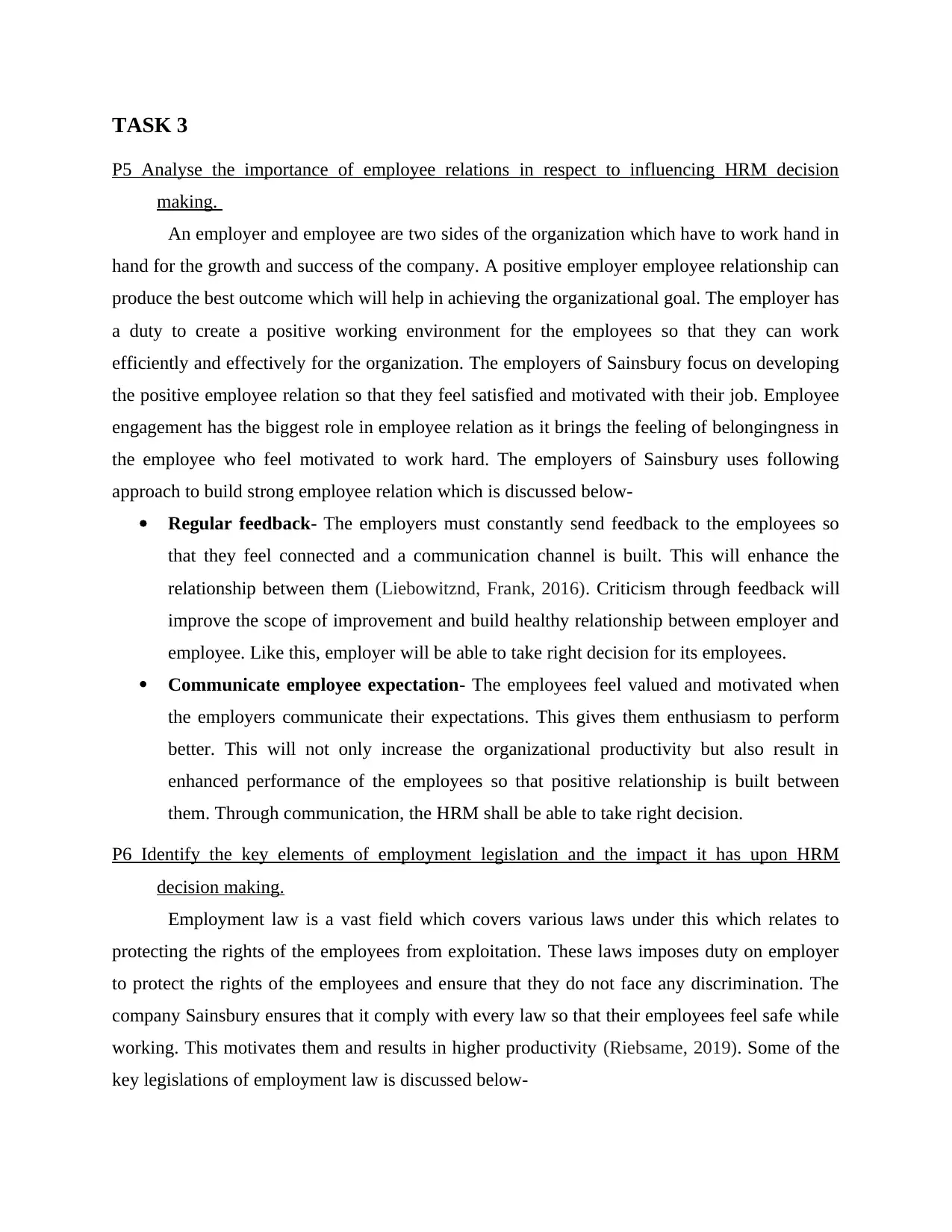
TASK 3
P5 Analyse the importance of employee relations in respect to influencing HRM decision
making.
An employer and employee are two sides of the organization which have to work hand in
hand for the growth and success of the company. A positive employer employee relationship can
produce the best outcome which will help in achieving the organizational goal. The employer has
a duty to create a positive working environment for the employees so that they can work
efficiently and effectively for the organization. The employers of Sainsbury focus on developing
the positive employee relation so that they feel satisfied and motivated with their job. Employee
engagement has the biggest role in employee relation as it brings the feeling of belongingness in
the employee who feel motivated to work hard. The employers of Sainsbury uses following
approach to build strong employee relation which is discussed below-
Regular feedback- The employers must constantly send feedback to the employees so
that they feel connected and a communication channel is built. This will enhance the
relationship between them (Liebowitznd, Frank, 2016). Criticism through feedback will
improve the scope of improvement and build healthy relationship between employer and
employee. Like this, employer will be able to take right decision for its employees.
Communicate employee expectation- The employees feel valued and motivated when
the employers communicate their expectations. This gives them enthusiasm to perform
better. This will not only increase the organizational productivity but also result in
enhanced performance of the employees so that positive relationship is built between
them. Through communication, the HRM shall be able to take right decision.
P6 Identify the key elements of employment legislation and the impact it has upon HRM
decision making.
Employment law is a vast field which covers various laws under this which relates to
protecting the rights of the employees from exploitation. These laws imposes duty on employer
to protect the rights of the employees and ensure that they do not face any discrimination. The
company Sainsbury ensures that it comply with every law so that their employees feel safe while
working. This motivates them and results in higher productivity (Riebsame, 2019). Some of the
key legislations of employment law is discussed below-
P5 Analyse the importance of employee relations in respect to influencing HRM decision
making.
An employer and employee are two sides of the organization which have to work hand in
hand for the growth and success of the company. A positive employer employee relationship can
produce the best outcome which will help in achieving the organizational goal. The employer has
a duty to create a positive working environment for the employees so that they can work
efficiently and effectively for the organization. The employers of Sainsbury focus on developing
the positive employee relation so that they feel satisfied and motivated with their job. Employee
engagement has the biggest role in employee relation as it brings the feeling of belongingness in
the employee who feel motivated to work hard. The employers of Sainsbury uses following
approach to build strong employee relation which is discussed below-
Regular feedback- The employers must constantly send feedback to the employees so
that they feel connected and a communication channel is built. This will enhance the
relationship between them (Liebowitznd, Frank, 2016). Criticism through feedback will
improve the scope of improvement and build healthy relationship between employer and
employee. Like this, employer will be able to take right decision for its employees.
Communicate employee expectation- The employees feel valued and motivated when
the employers communicate their expectations. This gives them enthusiasm to perform
better. This will not only increase the organizational productivity but also result in
enhanced performance of the employees so that positive relationship is built between
them. Through communication, the HRM shall be able to take right decision.
P6 Identify the key elements of employment legislation and the impact it has upon HRM
decision making.
Employment law is a vast field which covers various laws under this which relates to
protecting the rights of the employees from exploitation. These laws imposes duty on employer
to protect the rights of the employees and ensure that they do not face any discrimination. The
company Sainsbury ensures that it comply with every law so that their employees feel safe while
working. This motivates them and results in higher productivity (Riebsame, 2019). Some of the
key legislations of employment law is discussed below-
⊘ This is a preview!⊘
Do you want full access?
Subscribe today to unlock all pages.

Trusted by 1+ million students worldwide

National Minimum Wage Act, 1998- This legislation is designed to provide the rights to
employees to the minimum wages to which they are entitled. It places obligation on them
to provide minimum wages irrespective of their status in the company. Sainsbury ensures
that it pay minimum wages to its workforce.
Equality Act, 2010- This legislation ensure that fair and equal treatment is given to all
and there is no discrimination on any ground like colour, gender, race, etc. It imposes
duty on employers to give fair and equal opportunity to all so that they can wok
effectively. In case of any dispute between the people, the HR has to take decision fairly
and without any discrimination( Nicholas and Steyn 2017).
Health and safety at work Act, 1974- It is that legislation which imposes duty on
employer to provide safe working environment to the employees. The employee must
take all necessary measures to ensure safety of the workforce within the workplace. It
also places overriding duty on employees to comply with all safety measures so that their
own safety is ensured.
TASK 4
P7 Illustrate the application of HRM practices in a work-related context, using specific
examples.
HRM practices are are those which are used by the companies to bring productive change
in the working standards of the company so that productivity is enhanced. Sainsbury
systematically implement the HRM practices so that the company is moved towards growth and
success.
Advertisement for the job
Vacancy
Post – Sales manager
Qualification – Post graduation with specialisation in Human Resource
Experience – Minimum 3 years as HR.
employees to the minimum wages to which they are entitled. It places obligation on them
to provide minimum wages irrespective of their status in the company. Sainsbury ensures
that it pay minimum wages to its workforce.
Equality Act, 2010- This legislation ensure that fair and equal treatment is given to all
and there is no discrimination on any ground like colour, gender, race, etc. It imposes
duty on employers to give fair and equal opportunity to all so that they can wok
effectively. In case of any dispute between the people, the HR has to take decision fairly
and without any discrimination( Nicholas and Steyn 2017).
Health and safety at work Act, 1974- It is that legislation which imposes duty on
employer to provide safe working environment to the employees. The employee must
take all necessary measures to ensure safety of the workforce within the workplace. It
also places overriding duty on employees to comply with all safety measures so that their
own safety is ensured.
TASK 4
P7 Illustrate the application of HRM practices in a work-related context, using specific
examples.
HRM practices are are those which are used by the companies to bring productive change
in the working standards of the company so that productivity is enhanced. Sainsbury
systematically implement the HRM practices so that the company is moved towards growth and
success.
Advertisement for the job
Vacancy
Post – Sales manager
Qualification – Post graduation with specialisation in Human Resource
Experience – Minimum 3 years as HR.
Paraphrase This Document
Need a fresh take? Get an instant paraphrase of this document with our AI Paraphraser
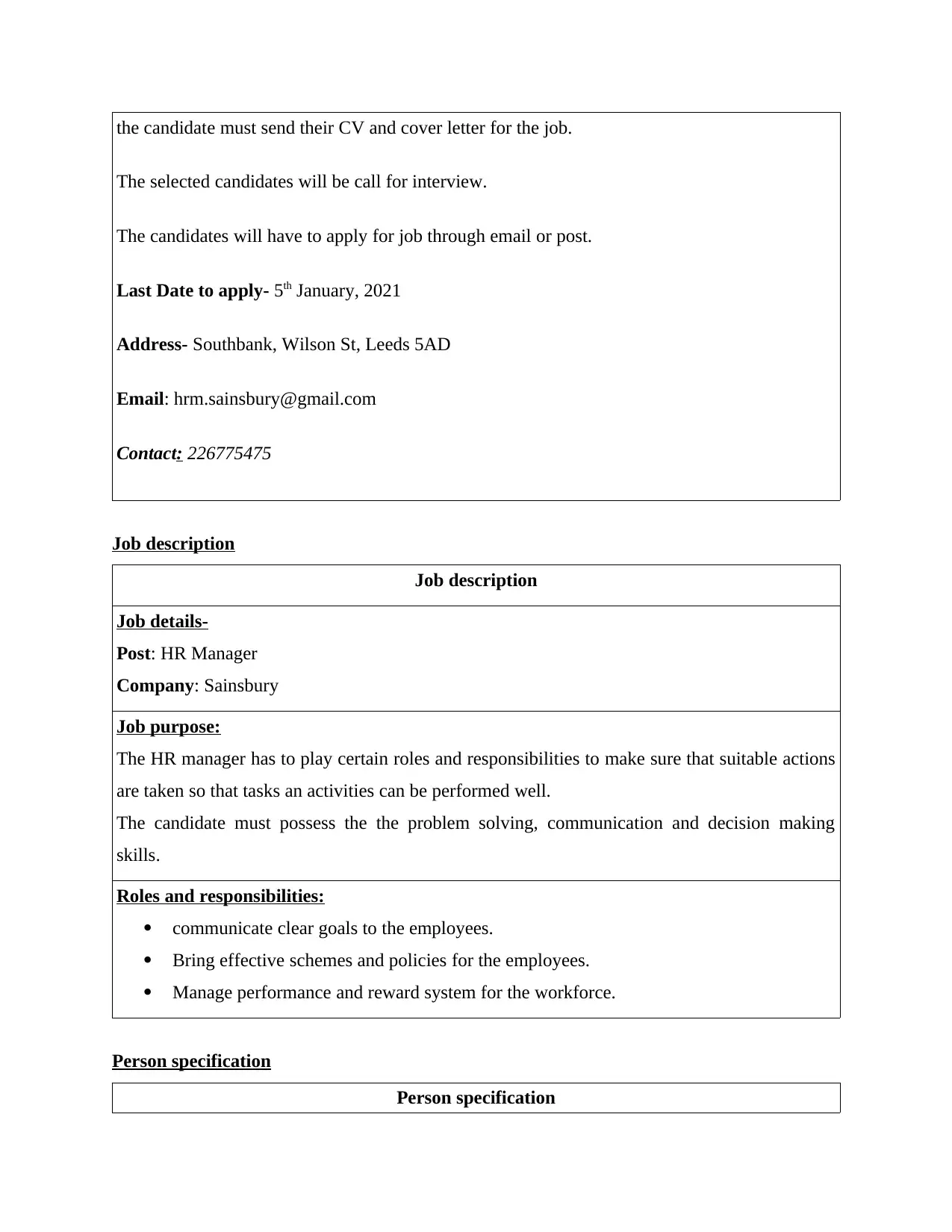
the candidate must send their CV and cover letter for the job.
The selected candidates will be call for interview.
The candidates will have to apply for job through email or post.
Last Date to apply- 5th January, 2021
Address- Southbank, Wilson St, Leeds 5AD
Email: hrm.sainsbury@gmail.com
Contact: 226775475
Job description
Job description
Job details-
Post: HR Manager
Company: Sainsbury
Job purpose:
The HR manager has to play certain roles and responsibilities to make sure that suitable actions
are taken so that tasks an activities can be performed well.
The candidate must possess the the problem solving, communication and decision making
skills.
Roles and responsibilities:
communicate clear goals to the employees.
Bring effective schemes and policies for the employees.
Manage performance and reward system for the workforce.
Person specification
Person specification
The selected candidates will be call for interview.
The candidates will have to apply for job through email or post.
Last Date to apply- 5th January, 2021
Address- Southbank, Wilson St, Leeds 5AD
Email: hrm.sainsbury@gmail.com
Contact: 226775475
Job description
Job description
Job details-
Post: HR Manager
Company: Sainsbury
Job purpose:
The HR manager has to play certain roles and responsibilities to make sure that suitable actions
are taken so that tasks an activities can be performed well.
The candidate must possess the the problem solving, communication and decision making
skills.
Roles and responsibilities:
communicate clear goals to the employees.
Bring effective schemes and policies for the employees.
Manage performance and reward system for the workforce.
Person specification
Person specification
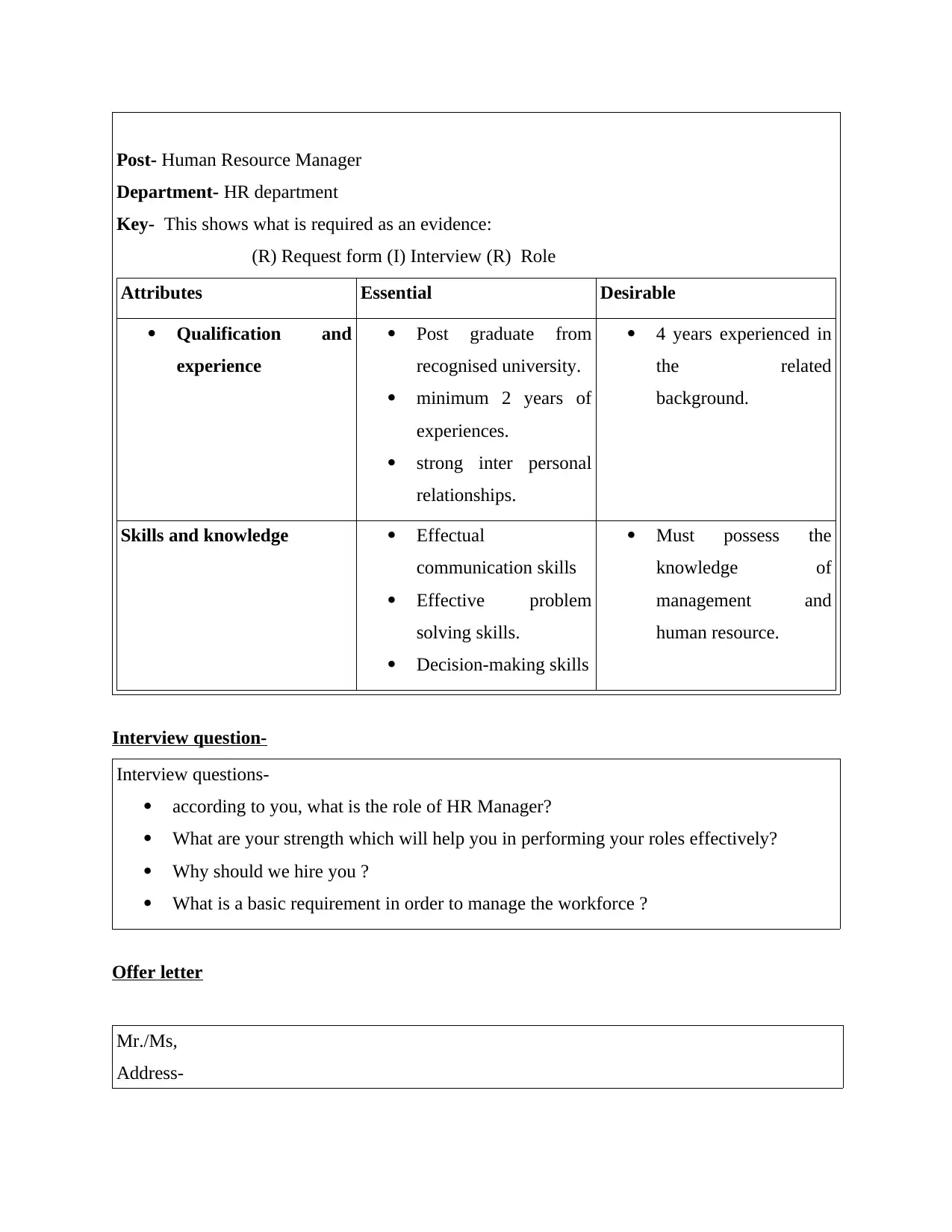
Post- Human Resource Manager
Department- HR department
Key- This shows what is required as an evidence:
(R) Request form (I) Interview (R) Role
Attributes Essential Desirable
Qualification and
experience
Post graduate from
recognised university.
minimum 2 years of
experiences.
strong inter personal
relationships.
4 years experienced in
the related
background.
Skills and knowledge Effectual
communication skills
Effective problem
solving skills.
Decision-making skills
Must possess the
knowledge of
management and
human resource.
Interview question-
Interview questions-
according to you, what is the role of HR Manager?
What are your strength which will help you in performing your roles effectively?
Why should we hire you ?
What is a basic requirement in order to manage the workforce ?
Offer letter
Mr./Ms,
Address-
Department- HR department
Key- This shows what is required as an evidence:
(R) Request form (I) Interview (R) Role
Attributes Essential Desirable
Qualification and
experience
Post graduate from
recognised university.
minimum 2 years of
experiences.
strong inter personal
relationships.
4 years experienced in
the related
background.
Skills and knowledge Effectual
communication skills
Effective problem
solving skills.
Decision-making skills
Must possess the
knowledge of
management and
human resource.
Interview question-
Interview questions-
according to you, what is the role of HR Manager?
What are your strength which will help you in performing your roles effectively?
Why should we hire you ?
What is a basic requirement in order to manage the workforce ?
Offer letter
Mr./Ms,
Address-
⊘ This is a preview!⊘
Do you want full access?
Subscribe today to unlock all pages.

Trusted by 1+ million students worldwide
1 out of 15
Related Documents
Your All-in-One AI-Powered Toolkit for Academic Success.
+13062052269
info@desklib.com
Available 24*7 on WhatsApp / Email
![[object Object]](/_next/static/media/star-bottom.7253800d.svg)
Unlock your academic potential
Copyright © 2020–2025 A2Z Services. All Rights Reserved. Developed and managed by ZUCOL.





